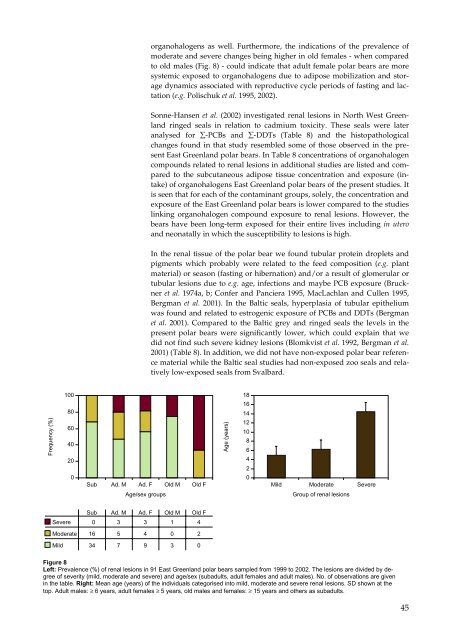Organohalogen concentrations and a gross and histologic ...
Organohalogen concentrations and a gross and histologic ...
Organohalogen concentrations and a gross and histologic ...
You also want an ePaper? Increase the reach of your titles
YUMPU automatically turns print PDFs into web optimized ePapers that Google loves.
Frequency (%)<br />
100<br />
80<br />
60<br />
40<br />
20<br />
Severe<br />
0<br />
Moderate<br />
Mild<br />
organohalogens as well. Furthermore, the indications of the prevalence of<br />
moderate <strong>and</strong> severe changes being higher in old females - when compared<br />
to old males (Fig. 8) - could indicate that adult female polar bears are more<br />
systemic exposed to organohalogens due to adipose mobilization <strong>and</strong> storage<br />
dynamics associated with reproductive cycle periods of fasting <strong>and</strong> lactation<br />
(e.g. Polischuk et al. 1995, 2002).<br />
Sonne-Hansen et al. (2002) investigated renal lesions in North West Greenl<strong>and</strong><br />
ringed seals in relation to cadmium toxicity. These seals were later<br />
analysed for ∑-PCBs <strong>and</strong> ∑-DDTs (Table 8) <strong>and</strong> the histopathological<br />
changes found in that study resembled some of those observed in the present<br />
East Greenl<strong>and</strong> polar bears. In Table 8 <strong>concentrations</strong> of organohalogen<br />
compounds related to renal lesions in additional studies are listed <strong>and</strong> compared<br />
to the subcutaneous adipose tissue concentration <strong>and</strong> exposure (intake)<br />
of organohalogens East Greenl<strong>and</strong> polar bears of the present studies. It<br />
is seen that for each of the contaminant groups, solely, the concentration <strong>and</strong><br />
exposure of the East Greenl<strong>and</strong> polar bears is lower compared to the studies<br />
linking organohalogen compound exposure to renal lesions. However, the<br />
bears have been long-term exposed for their entire lives including in utero<br />
<strong>and</strong> neonatally in which the susceptibility to lesions is high.<br />
In the renal tissue of the polar bear we found tubular protein droplets <strong>and</strong><br />
pigments which probably were related to the feed composition (e.g. plant<br />
material) or season (fasting or hibernation) <strong>and</strong>/or a result of glomerular or<br />
tubular lesions due to e.g. age, infections <strong>and</strong> maybe PCB exposure (Bruckner<br />
et al. 1974a, b; Confer <strong>and</strong> Panciera 1995, MacLachlan <strong>and</strong> Cullen 1995,<br />
Bergman et al. 2001). In the Baltic seals, hyperplasia of tubular epithelium<br />
was found <strong>and</strong> related to estrogenic exposure of PCBs <strong>and</strong> DDTs (Bergman<br />
et al. 2001). Compared to the Baltic grey <strong>and</strong> ringed seals the levels in the<br />
present polar bears were significantly lower, which could explain that we<br />
did not find such severe kidney lesions (Blomkvist et al. 1992, Bergman et al.<br />
2001) (Table 8). In addition, we did not have non-exposed polar bear reference<br />
material while the Baltic seal studies had non-exposed zoo seals <strong>and</strong> relatively<br />
low-exposed seals from Svalbard.<br />
18<br />
16<br />
14<br />
12<br />
10<br />
8<br />
6<br />
4<br />
2<br />
0<br />
Sub Ad. M Ad. F Old M Old F<br />
Mild Moderate Severe<br />
Age/sex groups Group of renal lesions<br />
Sub Ad. M Ad. F Old M Old F<br />
0 3 3 1 4<br />
16 5 4 0 2<br />
34 7 9 3 0<br />
Figure 8<br />
Left: Prevalence (%) of renal lesions in 91 East Greenl<strong>and</strong> polar bears sampled from 1999 to 2002. The lesions are divided by degree<br />
of severity (mild, moderate <strong>and</strong> severe) <strong>and</strong> age/sex (subadults, adult females <strong>and</strong> adult males). No. of observations are given<br />
in the table. Right: Mean age (years) of the individuals categorised into mild, moderate <strong>and</strong> severe renal lesions. SD shown at the<br />
top. Adult males: ≥ 6 years, adult females ≥ 5 years, old males <strong>and</strong> females: ≥ 15 years <strong>and</strong> others as subadults.<br />
Age (years)<br />
45

















